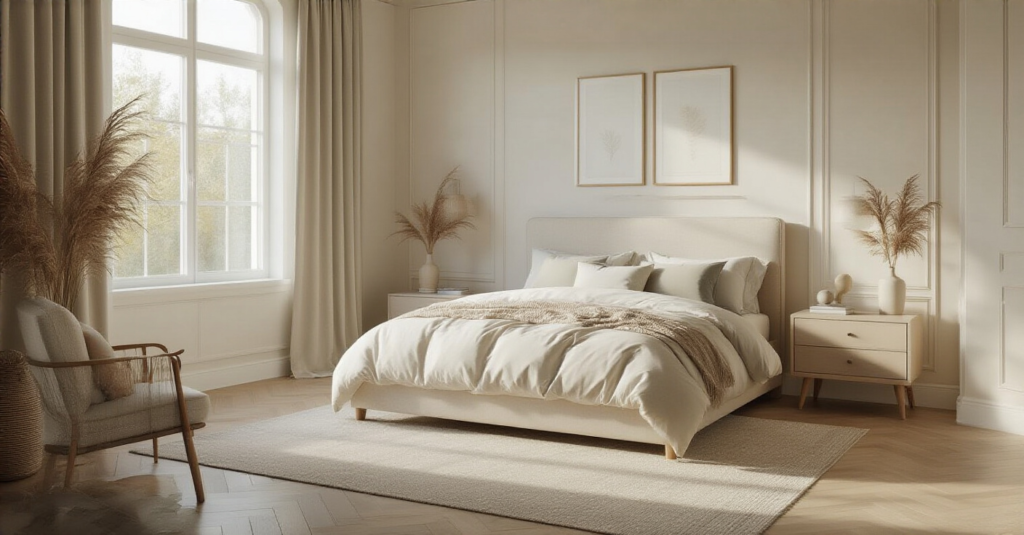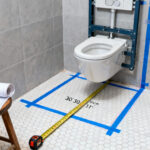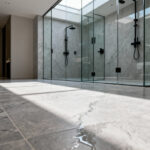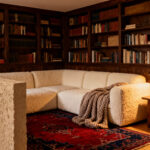You know the question people always ask me? They walk into my house, see my sleek, comfortable bedroom, and then they spot my two rescue mutts wrestling on the rug and the cat snoozing on a velvet chair. They look from the pets back to the furniture and ask, “How do you have nice things?” And I get it. For years in the vet clinic, I saw the aftermath of poorly chosen furniture—from dogs who’d eaten sofa cushions and needed surgery, to cats who’d toppled shelves. The common belief is that you have to choose: a stylish home or happy pets.
That’s the biggest lie in design. I used to think the same way until I realized it wasn’t about sacrifice; it was about being smarter. A truly beautiful home isn’t just one that looks good in a magazine; it’s one that functions for every single family member, including the furry ones. You just need to know the shortcuts, the right materials, and the little safety checks that make all the difference. This isn’t about covering everything in plastic. It’s about creating a gorgeous retreat that’s also a safe, comfortable haven for your animals. Let’s break down how to do it.
Laying the Foundation: Essential Furniture Choices
Everything starts here. These are the big-ticket items that anchor your room. If you get these right, the rest is just window dressing. But for us, “getting it right” means thinking about more than just color and style. It means considering wagging tails, climbing cats, and the occasional “oops” moment.
1. Determine Your Bed Size Needs (and Theirs, Too)
Okay, a King-size bed sounds luxurious, but when you have an 80-pound retriever who insists on sleeping sideways, that King suddenly feels like a Twin. The first thing to get real about is who you’re really sharing the bed with. Don’t just measure your room; measure your pet pile. A bigger bed means less chance of being passive-gressively kicked off the edge by a dreaming dog at 3 a.m. This is noise: obsessing over perfect room scale. This is what matters: can everyone sleep comfortably without falling off?
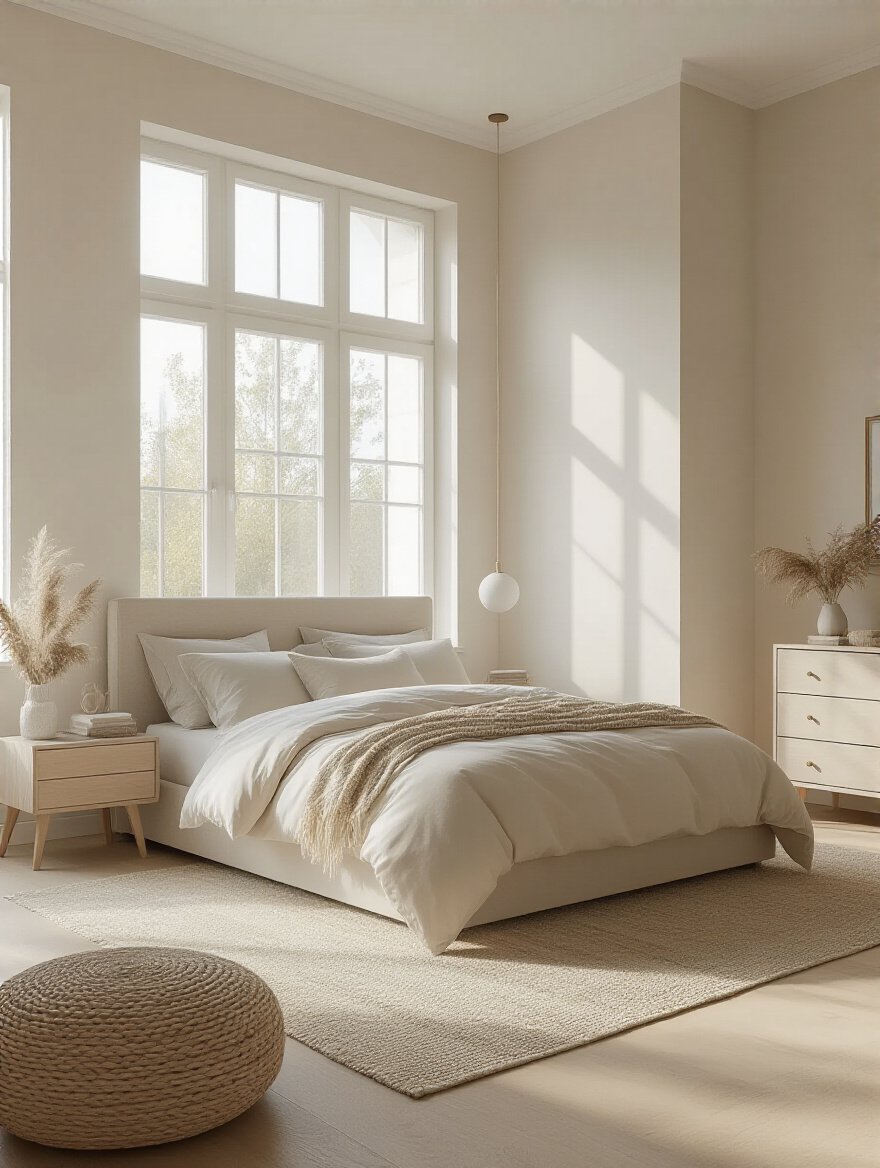
But it’s not just about width. As a vet tech, I saw so many older pets struggle with joint pain from jumping. The height of your bed matters. A super-high bed frame might look grand, but it’s a huge leap for a senior dachshund or a small dog. A lower-profile platform bed or simply forgoing a box spring can make a world of difference for their daily comfort and long-term joint health. It’s a simple change that shows them you’re thinking about their needs as they age.
With the bed size figured out, let’s talk about the frame it sits on, because this is a secret safety hazard.
2. Select an Ideal (and Safe) Bed Frame
The bed frame sets the tone, but it can also set a trap. Please, can we talk about how many frames are a disaster waiting to happen for pets? I’m talking about metal frames with ornate scrollwork that a cat’s collar can get snagged on, or wooden slats spaced just wide enough for a curious puppy to get his head stuck. Look for solid, simple designs. A solid platform base or a fully upholstered frame eliminates those risky gaps.

The other thing everyone gets wrong is material. They see a gorgeous, tweed upholstered headboard and fall in love. What I see is a five-star scratching post for a cat and a magnet for pet hair. Instead, think about Performance Fabrics like tightly woven microfiber, velvet (yes, velvet! It’s hard for claws to sink into), or even faux leather, which is a dream to wipe clean. These materials give you that luxe, stylish look without the constant stress of potential destruction. It’s a shortcut to sanity.
Next up, the part of the bed you can’t see, but might be the most important piece of all for pet parents.
3. Prioritize Your Mattress (and its Protector)
People spend thousands on an organic, breathable, cooling-gel mattress… and then a puppy has an accident on it and it’s ruined forever. I used to think a simple mattress cover was enough. I learned the hard way with a foster kitten that “water-resistant” and “waterproof” are two very different things. The single most important piece of “furniture” for any pet owner is a high-quality, fully encased, 100% waterproof mattress protector. It’s not optional. It’s everything.

A good protector is crinkle-free, breathable, and completely silent. You won’t even know it’s there, but it will save you from every possible pet-related fluid disaster: accidents, upset stomachs, muddy paws, you name it. It means you can invest in that incredible mattress you deserve without the constant, low-grade anxiety that it’s one incident away from the landfill. This isn’t just a purchase; it’s peace of mind.
Now that the bed is safe and sound, let’s turn our attention to the storage pieces that can pose a tipping risk.
4. Choose a Dresser or Wardrobe That’s Stable and Secure
A dresser seems harmless enough, right? But to a cat, a tall dresser with open drawers looks like the most amazing staircase ever invented. From a vet tech perspective, furniture tip-overs are a terrifyingly common and preventable accident. The absolute rule is this: any tall or heavy piece of furniture must be anchored to the wall. It’s a simple, five-minute job with a cheap anti-tip kit, and it can save your pet’s life.

Beyond safety, think about finishes. High-gloss lacquer will show every single nose-print and drool mark. A distressed or matte wood finish is much more forgiving. Look for hardware that’s smooth and simple, without dangling pulls that might look like a tempting chew toy to a bored puppy. Your goal is a piece that’s not only beautiful but also sturdy and uninteresting to your four-legged interior designers.
Once your clothes are safely stored, you’ll need a spot for your bedside essentials—a spot that’s off-limits to pets.
5. Identify Nightstand Functionality (aka Pet-Proofing Your Bedside)
People always ask me how to style their nightstand. My first question is always: “What do you need to keep away from your pet?” Your nightstand isn’t just a landing pad for a book and a glass of water. It’s often where we leave things that are incredibly toxic to our animals: a pack of sugar-free gum with xylitol, a bottle of Advil, or even certain hand lotions. My pet peeve is seeing open-top, minimalist nightstands in homes with pets. They’re an invitation for trouble.

The solution is simple: choose nightstands with drawers or enclosed cabinets. That way, all the dangerous-but-necessary stuff can be safely tucked away, and the top surface is reserved for safe items only—a lamp, a picture frame, maybe a pet-safe plant (like a spider plant, not a lily!). I learned this the hard way when a client’s dog ate an entire bottle of melatonin gummies and ended up in the ER. Closed storage is the shortcut to avoiding that kind of panic.
Mastering Key Pieces: Arrangement and Purpose
You’ve got the right pieces. Now, let’s put them in the right places. This is about creating a room that feels good to be in, both for you and for them. It’s about flow, function, and a few clever tricks to make the room feel calm and safe.
6. Optimize Bed Placement for Flow (and a Sense of Security)
Interior designers talk about placing the bed so you have a “commanding view” of the door. This isn’t just good Feng Shui; it’s also good pet psychology. Animals, especially dogs, often feel most secure when they can see the entrance to a room. It lets them relax because they know who’s coming and going. Placing your bed opposite the door, but not directly in line with it, gives both of you a sense of security.

The other key is creating clear “zoomie corridors.” Ever see a dog get a sudden burst of energy and do a lap around the room? They need clear pathways. Arranging your furniture to provide an open loop around the bed or along the perimeter prevents them from crashing into things and makes the room feel larger and less cluttered. It’s about anticipating their movement patterns, not just your own.
Now that your bed is perfectly placed, let’s shed some light on the situation—safely.
7. Pair Nightstands with Complementary (and Stable) Table Lamps
A happy, wagging tail is a wonderful thing… until it sends a $200 lamp crashing to the floor. When you have pets, especially larger dogs, everything needs to pass the “wobble test.” When choosing lamps for your nightstands, look for ones with a heavy, wide, and stable base. A skinny metal stick lamp is just asking for trouble. Ceramic or stone bases are fantastic options.

The other major safety concern is cords. I’ve treated more than one pet for electrical burns from chewing on a lamp cord. It’s a terrifying and expensive emergency. Run your cords behind the nightstand and use cord concealers or clips to secure them tightly against the wall, well out of reach. It’s a tiny detail that makes a massive difference in the safety of your home.
With the lighting handled, let’s talk about what goes on top of your other surfaces.
8. Maximize Dresser Top Space with Organized (and Pet-Safe) Arrangements
A beautifully styled dresser top can be the jewel of a bedroom. But when you have pets, you have to curate with caution. Forget tiny, delicate objects that can be easily swallowed. Think bigger, heavier, and more stable. Group items on a heavy tray to give them visual weight and make them less likely to be knocked over by a swishing tail.

“A styled surface in a pet-friendly home should follow one rule: if a cat can’t knock it over or a dog can’t swallow it, it’s a candidate. Everything else is a liability.”
I also see a lot of people putting bouquets of fresh flowers in the bedroom, which I love! But so many common flowers are highly toxic. Lilies, for instance, are fatally poisonous to cats—even the pollen can cause kidney failure. Instead, opt for pet-safe greenery like ferns, spider plants, or orchids, or just invest in some high-quality faux botanicals. You get the beauty without the risk.
Next, let’s carve out a little spot just for you, whether it’s for work or getting ready for the day.
9. Incorporate a Vanity Table or Desk (and Secure Your Supplies)
Having a dedicated spot to work or do your makeup is a wonderful luxury. For pet owners, it’s also another zone to secure. Think about all the things on a vanity that are tempting chew toys: makeup sponges, brushes, hair ties. And at a desk, you have cords, pens, and other small items. The key is, once again, smart storage.
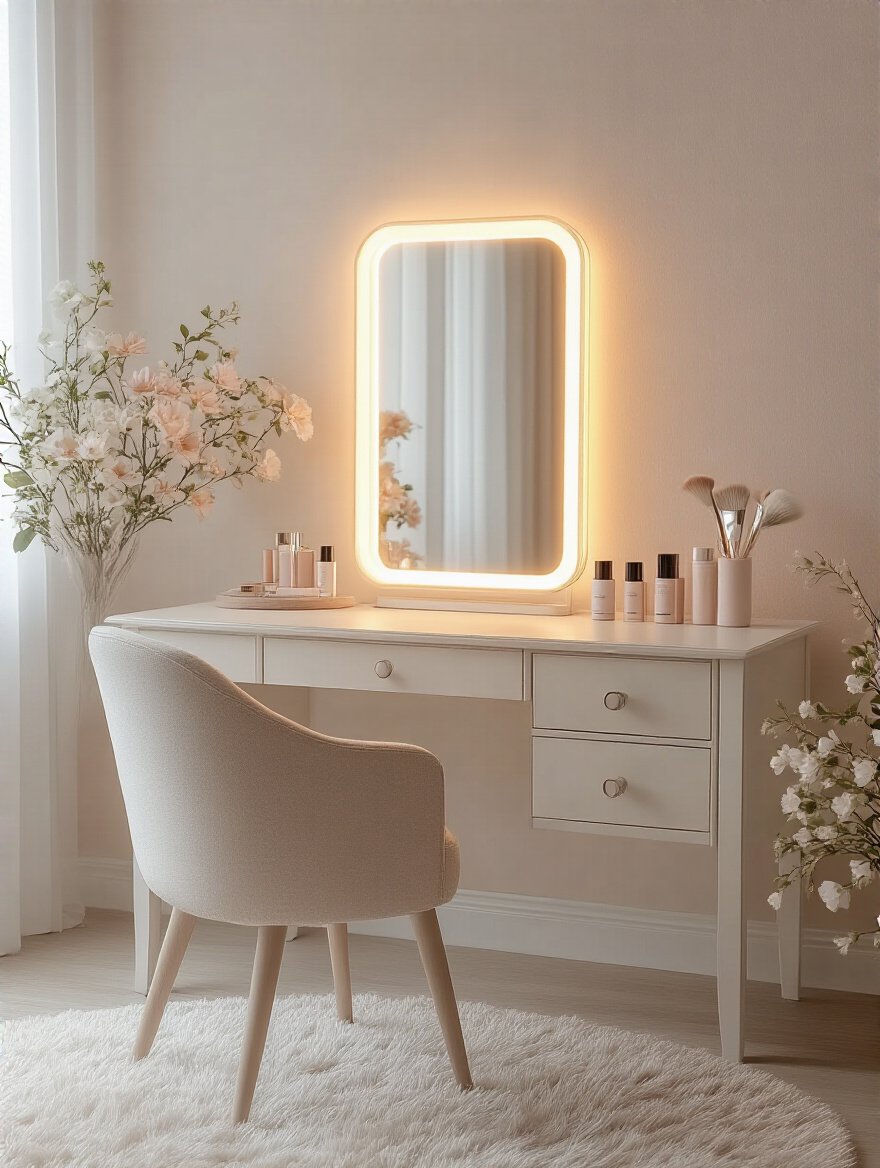
Choose a vanity or desk with drawers where you can sweep everything away at the end of the day. A clean surface isn’t just good for your own mental clarity; it’s a non-tempting surface for your pets. If you need open storage, use lidded boxes or containers. The goal is to make your personal items inaccessible. This isn’t about hiding things; it’s about protecting your pets and your belongings.
Finally, let’s add the coziest element of all—a piece of furniture you might buy for yourself but will immediately be claimed by them.
10. Select an Accent Chair or Chaise for Shared Relaxation
Let’s be honest: that beautiful accent chair you’re dreaming of for your reading nook? It’s going to be your pet’s new favorite bed. And that’s okay! You just have to choose wisely. This is where fabric knowledge becomes your superpower. Avoid anything with a loose weave, like boucle or some linens, as claws can snag them in a heartbeat.
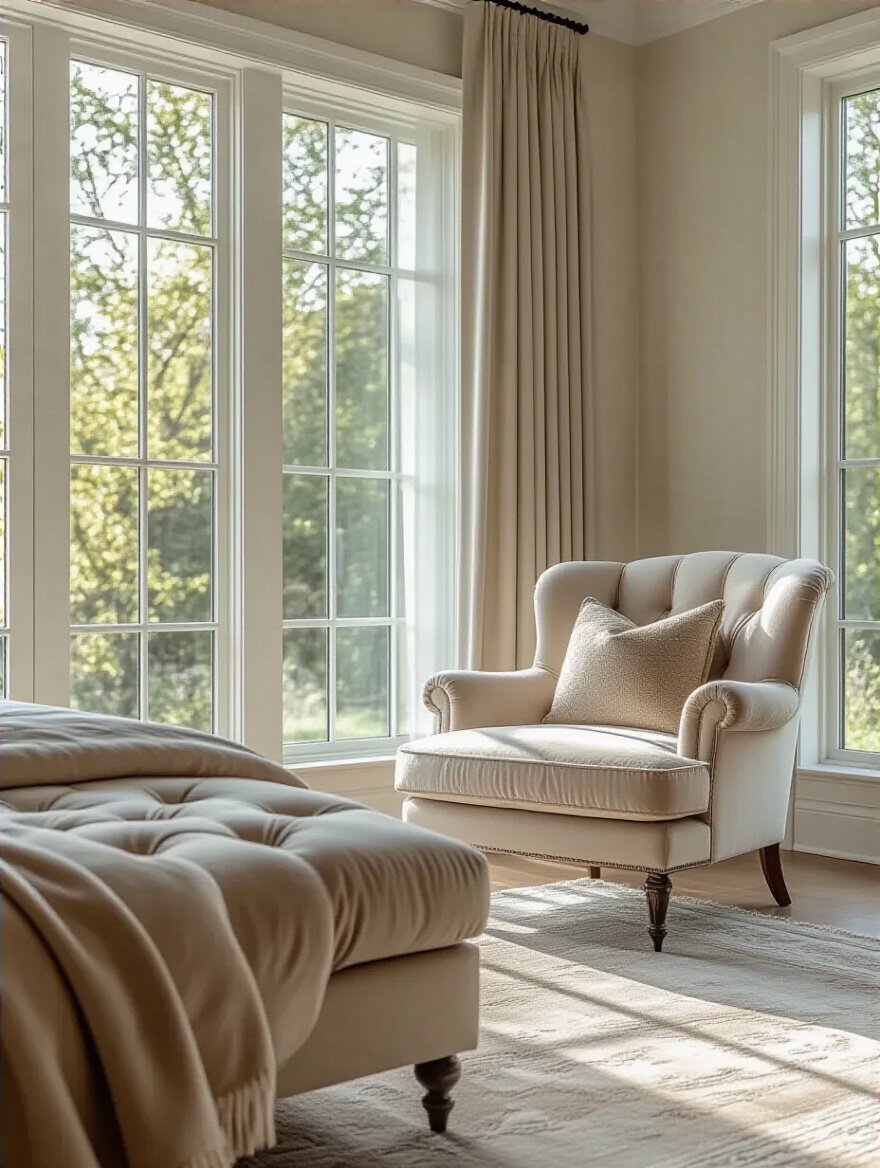
Your best friends are performance fabrics, leather (which is durable and can be repaired), or tightly woven fabrics like canvas, denim, or microfiber. I have a gorgeous, deep blue velvet accent chair that has survived years of cat naps and dog cuddles. The tight weave means claws don’t sink in, and fur brushes off easily. It’s the perfect intersection of style, comfort, and incredible durability.
Enhancing Style & Functionality with Accent Furniture
These are the “extra” pieces that take a room from functional to fabulous. They add layers of texture, purpose, and personality. For pet owners, they also offer golden opportunities to add function in disguise.
11. Integrate a Bedroom Bench as a Pet Staircase
A bench at the foot of the bed is a classic design move. For a pet owner, it’s also a brilliant piece of accessibility equipment in disguise. For small dogs, elderly pets, or breeds prone to back problems like Dachshunds, that jump from the floor to the bed can be a real strain on their joints over time. A sturdy, upholstered bench provides the perfect intermediate step.
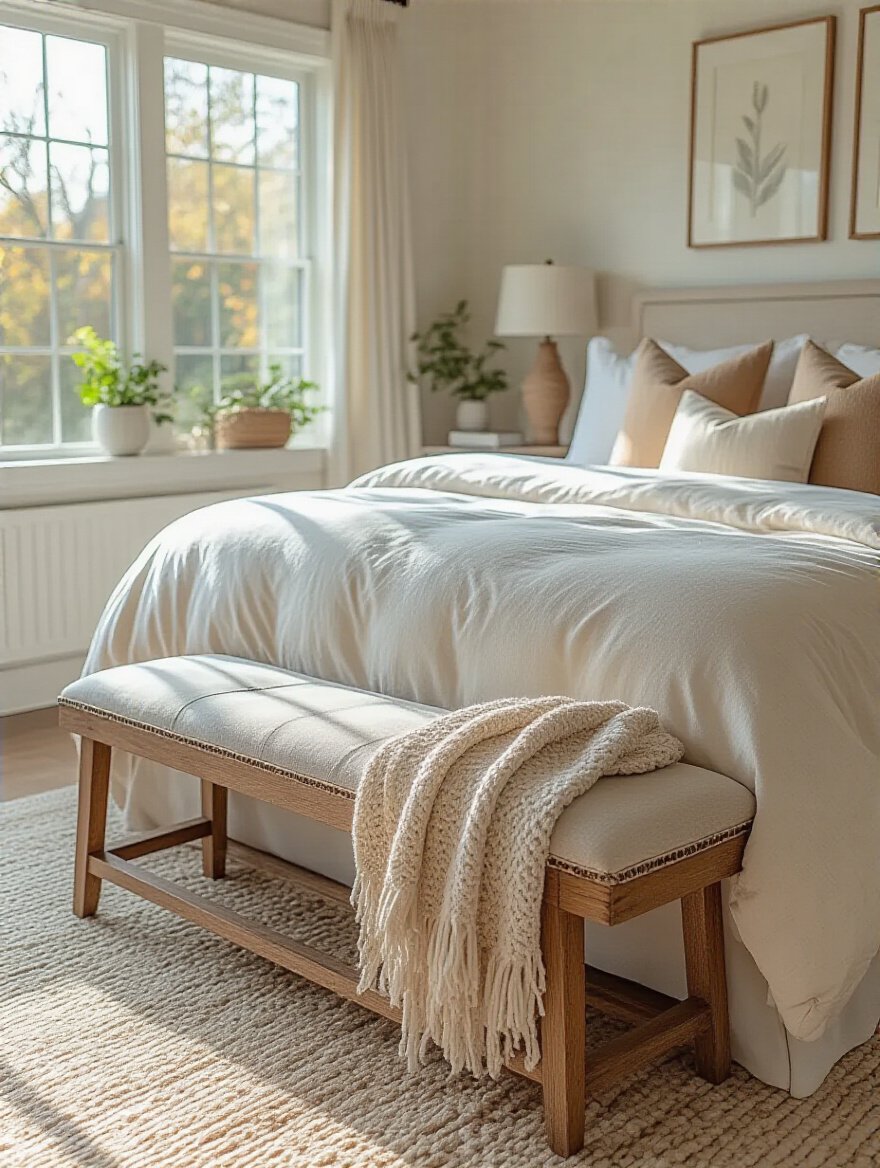
I tell all my clients with senior pets about this. It’s such an elegant solution. They get a chic, stylish bench that completes the look of their bed, and their dog gets a safe, easy way to join them for cuddles. Choose one with a durable, easy-to-clean fabric, and it’s a win-win. Some even come with built-in storage for hiding extra blankets or pet toys.
Now for another small but mighty piece that offers similar pet-friendly perks.
12. Utilize Ottomans or Poufs for Flexible…Everything
Poufs and ottomans are the Swiss Army knives of pet-friendly design. They can be a footrest for you, an extra seat for guests, or—you guessed it—another low-level perch for your pet. They are especially great for cats who like to have multiple napping spots at different heights throughout a room. A sturdy pouf next to a window can become their favorite bird-watching station.

When choosing one, think durability. A leather or faux leather pouf can be wiped clean in seconds. A jute or tightly woven wool pouf is surprisingly resistant to cat scratching (it mimics a scratching post, so they often prefer it to the sofa!). And if you get a storage ottoman, you suddenly have the perfect hidden spot for stashing grooming tools, toys, or bags of treats.
From the floor, let’s move our eyes upward to the walls.
13. Install Decorative Shelving (with Cat-Climbing in Mind)
Floating shelves are a great way to display decor without taking up floor space. But if you have a cat, you must accept a simple truth: any shelf is a cat highway. The belief that you can put fragile items on a high shelf “out of reach” is a myth. So, you have two options: either don’t put anything breakable on them, or secure your treasures.

A little trick I learned is to use museum wax or putty. It’s a clear, sticky substance that you can put on the bottom of a vase or picture frame to anchor it to the shelf. It’s strong enough to prevent an accidental bump from a cat’s tail from sending it flying, but it’s easily removable and won’t damage your items. And, of course, make sure the shelves themselves are securely mounted into studs.
For a different kind of vertical element, let’s talk about dividing your space.
14. Choose a Room Divider for Privacy (or Peaceful Pet Intros)
A room divider might seem like an old-fashioned piece of furniture, but it’s incredibly useful in a modern pet home. If you’re bringing a new foster animal home, a sturdy screen can be a fantastic tool for slow, safe introductions. It allows pets to smell each other and get used to each other’s presence without direct contact, which can dramatically reduce stress and conflict.
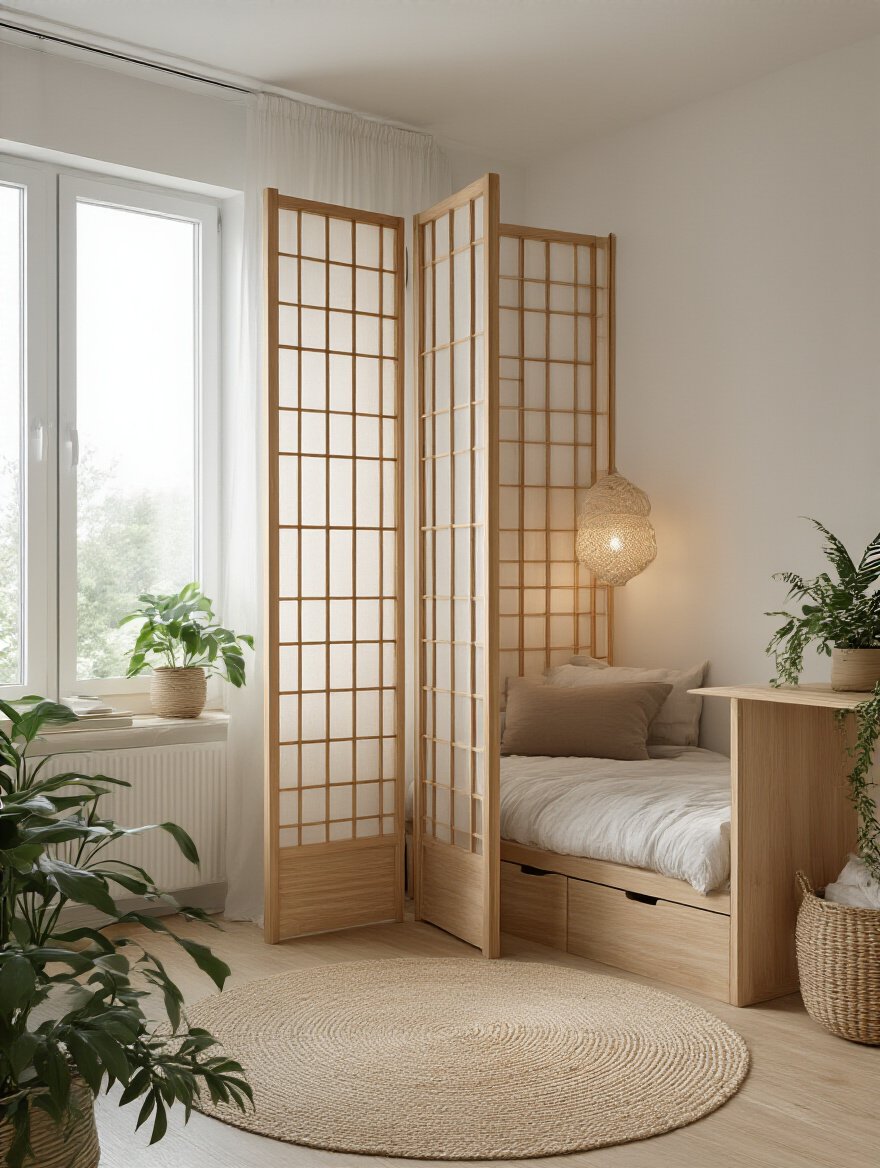
It can also be used to temporarily block off a part of the room if you need a pet-free zone for a bit. Look for solid, heavy dividers that can’t be easily knocked over. A flimsy paper screen won’t last a day. A solid wood or upholstered screen, on the other hand, can be both a beautiful design element and a practical pet management tool.
Last in this section is the big black box that can ruin a serene bedroom vibe if you’re not careful.
15. Select a Media Console That Hides the Tech
If you have a TV in your bedroom, the biggest challenge is managing the tech clutter—especially the cords. Dangling cords are a serious hazard; they look like chew toys to puppies and fun playthings to kittens. This is a non-negotiable safety issue. You need a media console that keeps everything contained.

The best choice is a console with solid doors, not glass. This completely hides the mess of devices and, more importantly, keeps the cords tucked safely inside and out of reach. Look for a unit with built-in cable management holes in the back. This allows you to route all the wires out of sight and securely against the wall, creating a clean, seamless look that is, most importantly, 100% safe.
Smart Strategies for Space & Flow Optimization
This is where we fine-tune everything. These strategies are about making your bedroom feel as good as it looks—effortless, open, and intuitive for every member of your family.
16. Maximize Small Bedrooms with Clever Multi-Functional Furniture
In a small space, every piece of furniture has to earn its keep. A captain’s bed with deep drawers underneath is a game-changer. It can eliminate the need for a bulky dresser, freeing up valuable floor space for a dog bed or a play area. That space you save is gold.
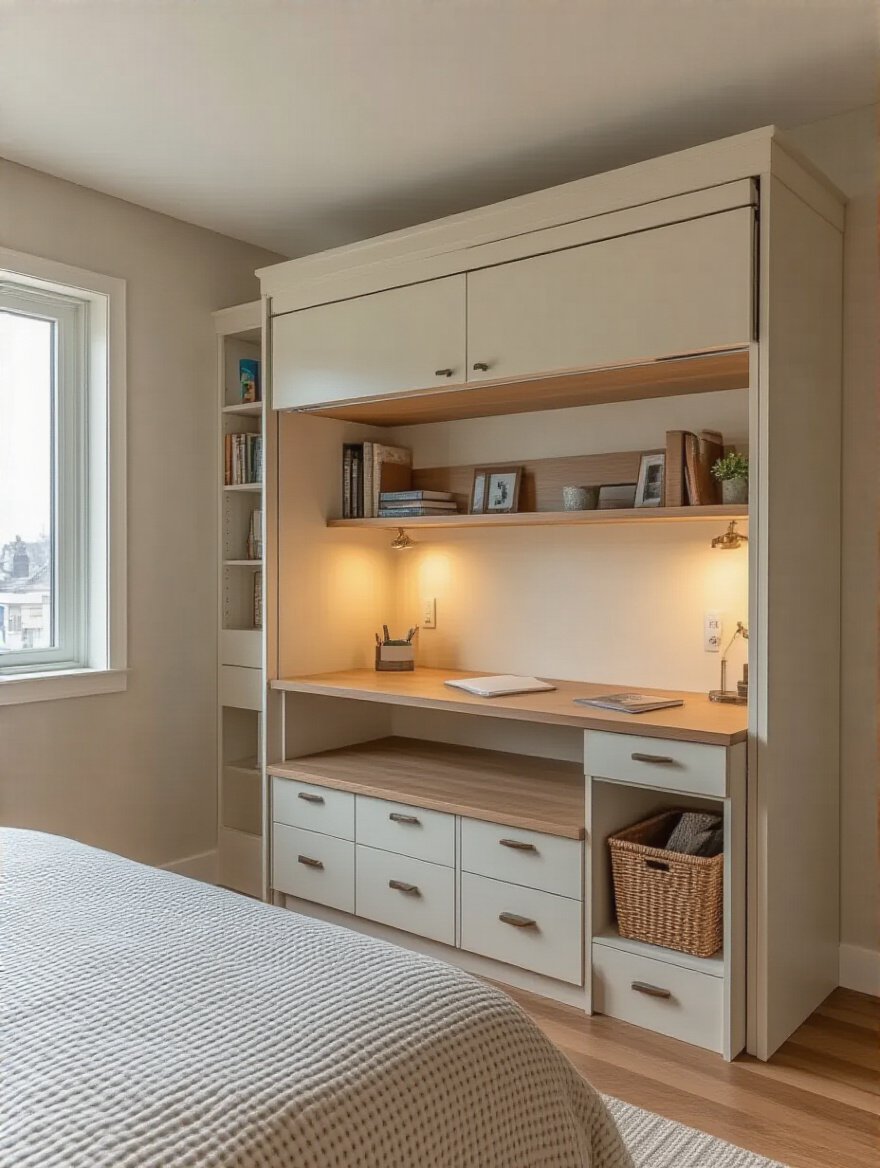
Another one of my favorites is the storage bench I mentioned earlier. It’s seating, it’s a pet-step, and it’s storage all in one. A simple wall-mounted folding desk can serve as a workspace when you need it and fold up to be nearly invisible when you don’t, keeping the floor clear for epic games of fetch with a soft toy. Thinking this way isn’t about compromise; it’s about being ingeniously efficient.
The ultimate version of this idea takes it a step further.
17. Implement Built-In Storage to Create Ultimate Calm
If you really want to achieve a serene, clutter-free bedroom that can withstand the beautiful chaos of pets, built-in storage is the holy grail. Think a full wall of floor-to-ceiling closets with a space for everything. When everything is behind a closed door, it doesn’t matter if your dog’s toy collection is a mess or your cat has 15 different types of food. It’s all hidden.

Built-ins create an incredibly calm and streamlined look because they eliminate the visual noise of freestanding furniture. There are no gaps for dust bunnies (or pet hair tumbleweeds) to collect. It’s an investment, for sure, but the payoff in terms of daily sanity and a perpetually tidy-looking space is immeasurable.
Now, let’s talk about how to navigate the space you’ve created.
18. Arrange Furniture to Optimize Walkways and Promote “Zoomie” Corridors
I mentioned this before, but it’s worth its own point. You have your walking paths, but your pets have theirs, too. Watch how they move through the room. Do they have a favorite path from the door to their bed? Do they like to circle the room when they get excited? Honor those paths. Don’t block them with a pouf or a plant.

A room with good flow feels bigger and more peaceful. It reduces stress because no one is bumping into things or feeling trapped. Leave generous space—at least 30 inches for major pathways. This ensures a happy dog with a wagging tail doesn’t clear a whole side table, and a cat chasing a toy doesn’t cause a pile-up.
Next, a trick to make all that open space feel even bigger.
19. Leverage Mirrors and Reflective Surfaces (But Anchor Them!)
Mirrors are magic for making a room feel larger and brighter. A big, beautiful floor-length mirror leaning against a wall is a classic designer trick. But in a pet home, “leaning” is a four-letter word. Any large mirror must be securely anchored to the wall. All it takes is one rambunctious dog or climbing cat to send it crashing down, which is a serious danger to both your pet and the mirror.
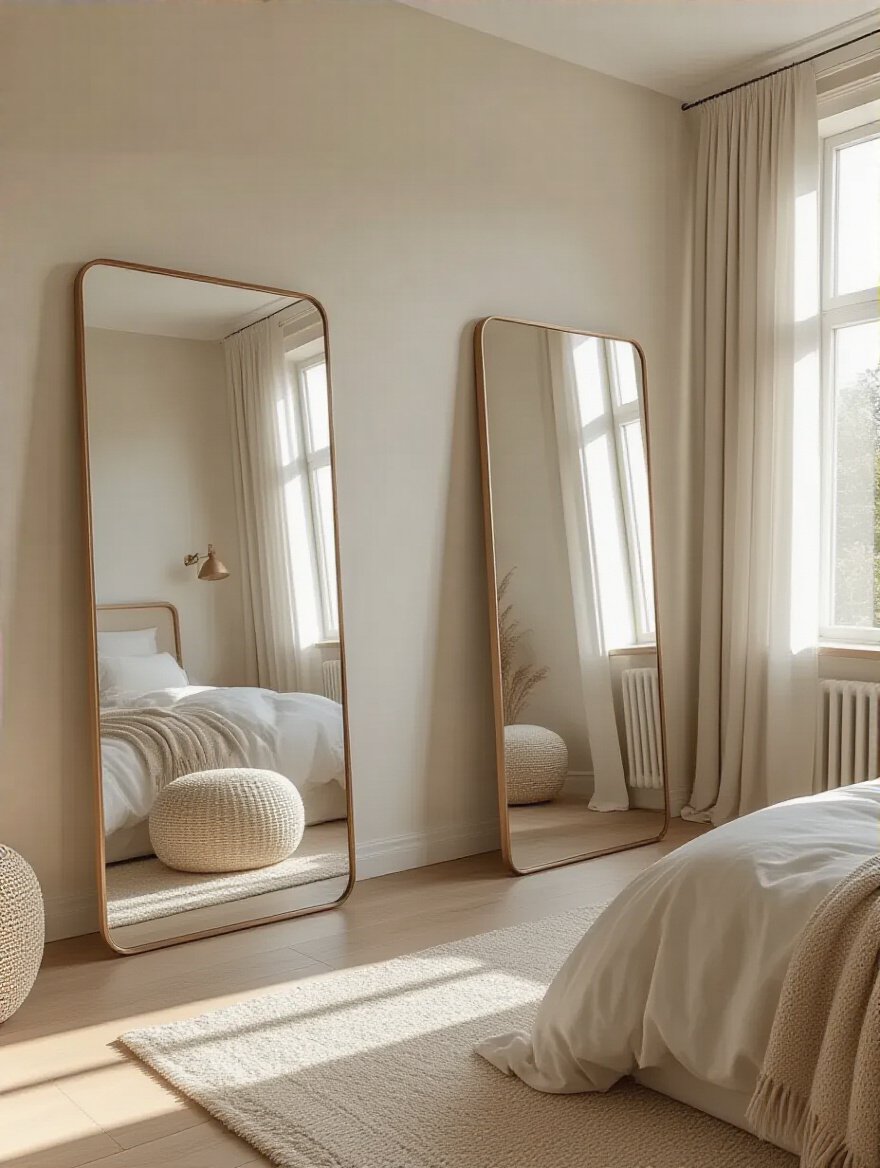
So, go for the big mirror! Use it to reflect light from a window and double your space visually. Just take the extra two minutes to install safety brackets or anti-tip hardware. You get all the stylish benefits without any of the risks. It’s the responsible way to do glam.
And finally, let’s think about the long haul.
20. Plan for Future Furniture Additions and Your Pet’s Life Stages
Your two-year-old, high-energy Lab has very different needs than he will as a twelve-year-old senior. Great design anticipates this. Maybe you don’t need that bench at the foot of the bed right now, but leaving space for it is a smart move. Planning for the future means choosing timeless, durable core pieces and leaving a little flexible space.
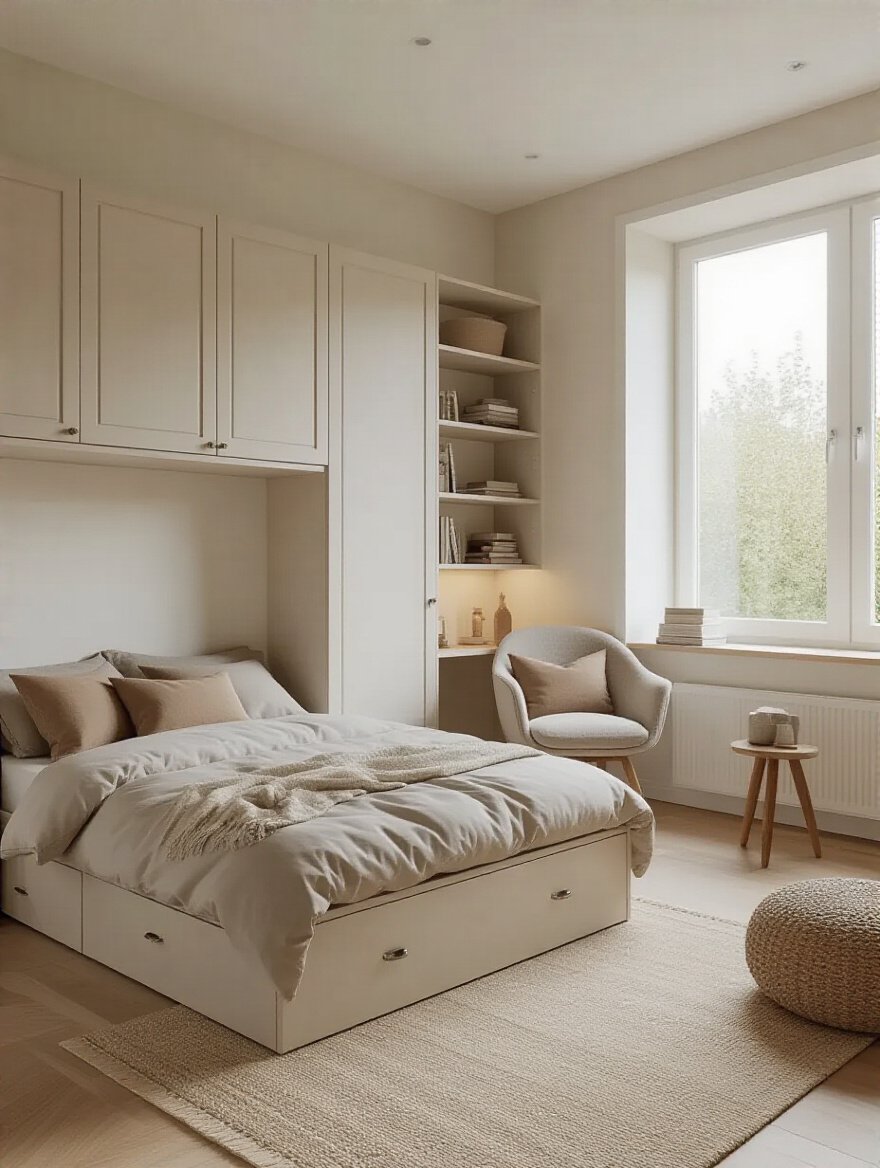
This could mean leaving a corner of the bedroom empty for now, knowing it might one day house a cozy, orthopedic dog bed. Or it could mean choosing a modular closet system that you can reconfigure as your needs change. It’s about designing a room that can grow and evolve with you and your pets, ensuring your beautiful retreat serves you all for years to come.
Conclusion
See? It’s not about choosing between your pets and a home you love. It’s about being thoughtful. It’s about understanding that a truly well-designed space is one that is safe, comfortable, and beautiful for everyone who lives in it. By choosing durable materials, prioritizing safety, and making a few smart, multi-functional choices, you can absolutely create that dream retreat you’ve been pinning on Pinterest. A place where you can relax, your pets can thrive, and you never have to worry that a wagging tail or a curious cat will undo all your hard work.
Your home should be a reflection of your whole family, and our pets are family. So go ahead, get the velvet chair. Buy the big, cozy rug. Create the stunning, serene bedroom you deserve. You now have the vet-tech-approved, designer-endorsed playbook to make sure it’s perfect for you and for them.
